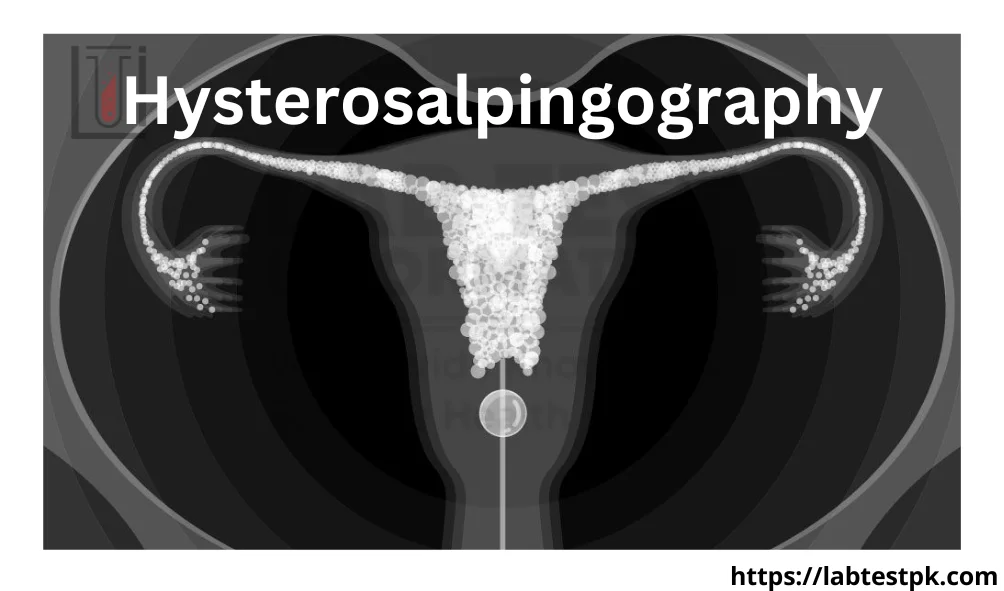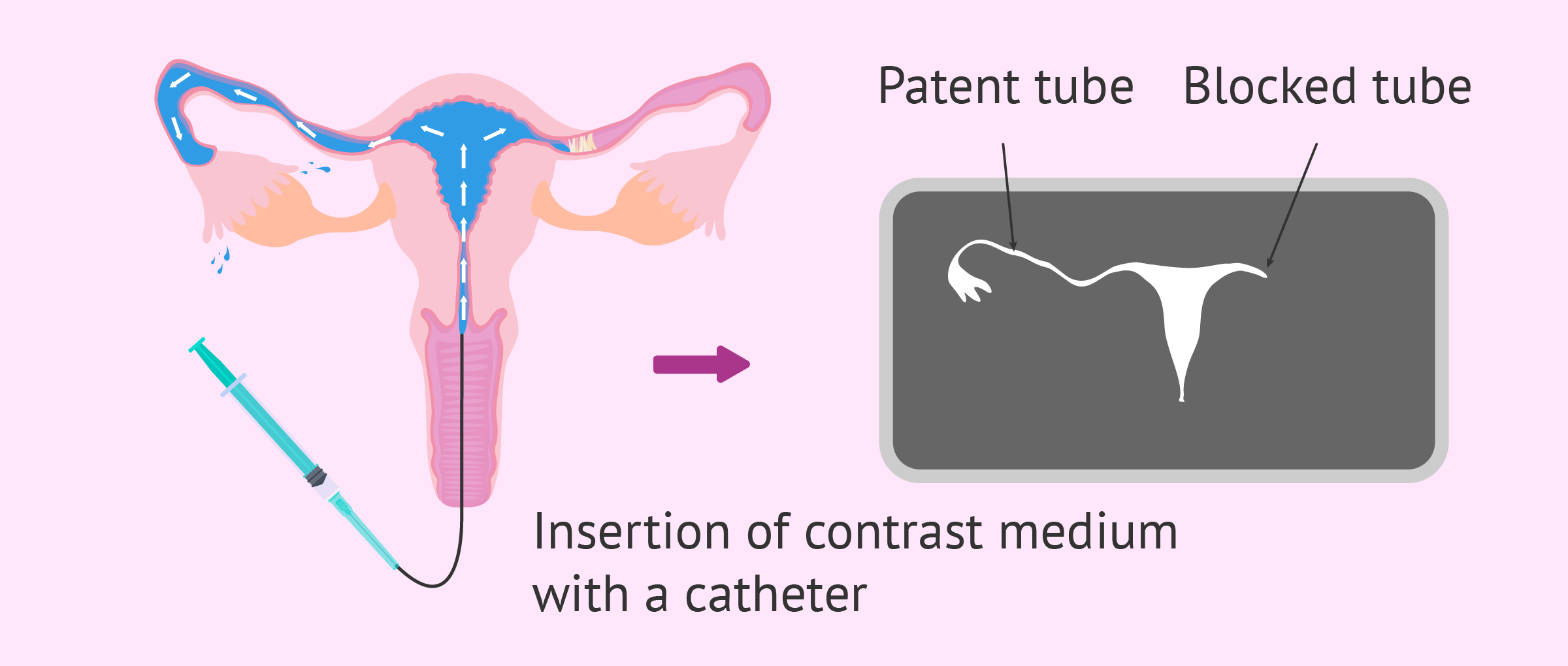Hysterosalpingography (HSG)
Hysterosalpingography (HSG) is a medical procedure that involves imaging the uterus and Fallopian tubes using X-rays and a contrast dye. It is commonly used to evaluate the female reproductive system, especially when there are concerns about fertility or potential issues with the uterus and fallopian tubes.
Procedure of Hysterosalpingography
a) Preparation:
- The patient’s medical history and any potential allergies are reviewed.
b) Contrast Medium:
- A contrast dye is introduced into the uterus through the cervix.
- This dye is usually made visible on X-ray images, allowing the structures to be clearly seen.
c) Imaging:
- X-ray images are taken while the dye is being introduced and as it flows through the uterus and fallopian tubes.
- The images can help reveal any abnormalities, such as blockages, irregularities in the shape of the uterus, or problems with the fallopian tubes.
d) Observation:
- The radiologist or healthcare provider closely examines the images to identify any issues.
- The flow of the dyes can help determine if the fallopian tubes are open and if there are any obstructions.
HSG can provide valuable information about various reproductive conditions, including:
1. Blocked fallopian tubes:
- A common cause of female infertility is a blockage in the fallopian tubes, which can prevent the sperm from reaching the egg or the fertilized egg from moving into the uterus.
2. Uterine abnormalities:
- HSG can identify structural issues within the uterus, such as a septum ( a wall dividing the uterus ), fibroids ( Non-cancerous growths ), or polyps ( small growths on the uterine lining).
3. Unexplained infertility:
- If all other tests appear normal, HSG can help identify suitable abnormalities that might not be detectable through other means.
4. Evaluating tubal sterilization:
- HSG can be used to confirm the success of a tubal ligation procedure, where the fallopian tubes are intentionally blocked or scaled to prevent pregnancy.
5. Ectopic pregnancy:
- An ectopic pregnancy occurs when a fertilized egg implants outside the uterus, often in a fallopian tube.
NOTE:
Worth noting that while HSG is a valuable diagnostic tool, it does involve a small amount of radiation exposure due to the X-rays. The procedure is generally considered safe, but as with any medical procedure, there can be risks and potential discomfort. It is important to discuss any concerns or potential risks with your healthcare provider before undergoing the procedure.
What will I experience during and after the procedure?
Here’s what you can generally expect during and after the procedure:
During the HSG Procedure:
- Preparation: Before the procedure, you may be asked to change into a hospital gown. A radiologic technologist will explain the procedure and answer any questions you have. You might also be given a mild pain reliever or antibiotics to reduce the risk of infection.
- Positioning: You’ll lie on an X-ray table with your feet in stirrups, similar to a pelvic exam. A speculum is used to open the vaginal canal, and a catheter is inserted into the cervix.
- Contrast Injection: A contrast material (usually iodine-based) is injected through the catheter into the uterus. This material helps highlight the shape and structure of the uterus and fallopian tubes when viewed with X-ray or fluoroscopy.
- X-ray Imaging: X-ray images are taken in real-time as the contrast material fills the uterus and flows into the fallopian tubes. This allows the healthcare provider to assess the structures and detect any abnormalities, such as blockages or abnormalities.
- Sensations: You may experience some cramping or discomfort during the procedure as the uterus and fallopian tubes are filled with contrast material. Some women also report a feeling of pressure or a warm sensation.
After the HSG Procedure:
- Immediate Recovery: The procedure itself usually takes about 10-15 minutes. You’ll be monitored for a short time afterward to ensure there are no immediate complications or severe discomfort. You might have some spotting or light bleeding, which is normal.
- Pain and Discomfort: You may experience cramping, mild discomfort, or a sensation similar to menstrual cramps after the procedure. This discomfort typically subsides within a few hours to a couple of days.
- Return to Normal Activities: You can usually return to your normal activities the same day, but some healthcare providers may recommend avoiding sexual intercourse or using tampons for a brief period following the procedure.
- Follow-Up: Your healthcare provider will discuss the results with you, and if any issues are identified, they will develop a plan for further evaluation or treatment.
- Possible Side Effects: While rare, complications such as infection, allergic reaction to the contrast material, or injury to the uterus can occur. If you experience symptoms like severe pain, heavy bleeding, fever, or signs of infection, contact your healthcare provider immediately.
What are the limitations of Hysterosalpingography?
Hysterosalpingography (HSG) is a medical imaging procedure used to evaluate the female reproductive system, specifically the uterus and fallopian tubes. While it is a valuable diagnostic tool, it has several limitations and potential drawbacks:
- Discomfort and Pain: Some women may experience discomfort or pain during the procedure, particularly when the contrast material is injected into the uterus. This can cause cramping and temporary discomfort.
- Allergic Reactions: Although rare, there is a risk of allergic reactions to the contrast material used in HSG. It’s important for healthcare providers to inquire about any prior allergic reactions to contrast agents.
- Invasive Nature: HSG is an invasive procedure, involving the insertion of a catheter into the cervix. This may lead to the risk of infection, especially if proper aseptic techniques are not followed.
- Radiation Exposure: HSG involves the use of X-rays to visualize the reproductive organs. While the radiation exposure is relatively low, it is not recommended for pregnant women due to potential risks to the developing fetus.
- Limited View: HSG primarily evaluates the uterine cavity and fallopian tubes, but it does not provide a comprehensive view of the entire reproductive system. It cannot detect abnormalities in the ovaries, the presence of ovarian cysts, or endometriosis.
- False Positives and Negatives: HSG may produce false-positive or false-negative results. For instance, tubal spasm during the procedure can make it appear as if there is a blockage, leading to false-positive results. Conversely, the test might not detect subtle tubal abnormalities, leading to false-negative results.
- Temporary Effects: The effects of HSG, such as increased fertility immediately after the procedure, are generally temporary and may not result in a successful pregnancy.
- Limited Information: HSG provides information about the structure of the reproductive organs but cannot assess their functional capabilities. For example, it does not assess the ability of the fallopian tubes to transport eggs or the quality of the eggs.
- Limited Therapeutic Value: HSG is primarily a diagnostic tool and does not have a therapeutic role in treating reproductive issues.
- Follow-up Required: If abnormalities or blockages are identified during HSG, additional testing and evaluation may be needed to determine the underlying cause and develop a treatment plan.
- Patient Factors: The success of the HSG procedure can be influenced by various patient factors, such as obesity, anatomical variations, or cervical stenosis, which may make it more challenging to perform.




[…] of your uterus that connects to your vaginal canal. Sperm travels through the vaginal canal and cervix to your uterus to fertilize eggs. During pregnancy, the cervix closes to keep the baby in your womb […]
[…] of Platelet Disorders in Pregnancy: Some pregnant women may develop conditions like gestational thrombocytopenia, where platelet function is […]
[…] function. Low levels of Inhibin B may be indicative of impaired testicular function and reduced sperm […]
[…] Symptoms can include abnormal vaginal discharge, burning sensation during urination, and pain during sexual intercourse. […]